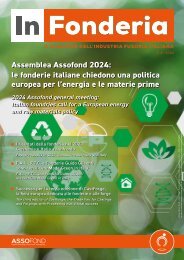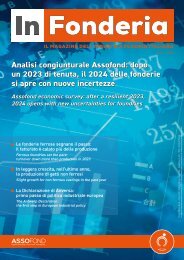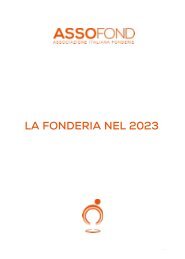In Fonderia 2 2024
Secondo numero del 2024 di In Fonderia
Secondo numero del 2024 di In Fonderia
Create successful ePaper yourself
Turn your PDF publications into a flip-book with our unique Google optimized e-Paper software.
IN PRIMO PIANO<br />
ministrativa, a volte le difficoltà sono dovute<br />
anche a una notevole refrattarietà del sistema<br />
alle semplificazioni stesse anche quando<br />
esse vengono introdotte dal legislatore. Emblematica<br />
è l’esperienza avuta da Assofond<br />
con alcuni enti competenti a seguito dell’introduzione<br />
nella normativa nazionale del comma<br />
8-septies dell’art. 216 del D. Lgs. n. 152/06 e<br />
s.m.i., che permette alle aziende in AIA di poter<br />
utilizzare all’interno del proprio ciclo produttivo<br />
determinati rifiuti non pericolosi (quali ad<br />
esempio rottami ferrosi puliti) semplicemente<br />
a seguito di una comunicazione all’autorità<br />
competente e al rispetto della tracciabilità degli<br />
stessi per mezzo del formulario, senza ulteriori<br />
adempimenti, normalmente richiesti per<br />
le attività di recupero rifiuti.<br />
Come già discusso in precedenza, la principale<br />
barriera che si pone di fronte a tutte le imprese<br />
che si stanno cimentando nell’individuazione<br />
di pratiche di economia circolare dei propri<br />
residui, specialmente se classificabili come<br />
sottoprodotti, è la determinazione di percorsi<br />
di simbiosi industriale per l’individuazione di<br />
una destinazione di utilizzo certa. <strong>In</strong> base all’esperienza<br />
di Assofond, su questo aspetto, le<br />
difficoltà alla chiusura del cerchio possono essere<br />
dovute alle caratteristiche merceologiche<br />
del materiale in riferimento alla specifica destinazione<br />
individuata, che possono renderlo<br />
non adeguato (ad esempio a causa della presenza<br />
di elementi o sostanze in tracce che andrebbero<br />
a compromettere le caratteristiche<br />
del bene generato con i residui di fonderia), o<br />
nella difficoltà di poter garantire una fornitura<br />
continua del materiale, sia dal punto di vista<br />
quantitativo sia merceologico.<br />
È parere comune che la realizzazione dell’economia<br />
circolare, di fatto, sarà possibile soltanto<br />
attraverso un allineamento e una cooperazione<br />
tra tutti i portatori di interessi a tutti i livelli<br />
(unionale, nazionale, regionale e locale). Per<br />
realizzarla, tutti i settori coinvolti, dalle imprese<br />
che stanno vagliando tutte le possibilità che<br />
riescono a individuare fino alle istituzioni che,<br />
con appositi bandi, impiegano le risorse economiche<br />
pubbliche, dovranno investire molte<br />
energie. <strong>In</strong> questi ultimi anni sono sempre di più<br />
i casi di successo che fanno ben sperare, ma<br />
ancora non è possibile dire se queste attività<br />
diventeranno strutturali ed estese a settori più<br />
ampi del mercato o se rischiano di essere solo<br />
delle fortunate esperienze isolate. •<br />
simplifications themselves even when they are<br />
introduced by the legislator. A typical experience<br />
is that of Assofond with some competent<br />
bodies following the introduction of the national<br />
legislation of paragraph 8-septies of art.<br />
216 of Italian Legislative Decree no. 152/06<br />
as amended, which allows AIA companies to<br />
use certain non-hazardous waste (e.g. clean<br />
ferrous scrap) in their production cycle simply<br />
following notification to the competent authority<br />
and compliance with its traceability using a<br />
form, without further requirements, normally<br />
necessary for waste recovery activities.<br />
As discussed before, the main barrier to all the<br />
companies that are dealing with identifying<br />
circular economy practices for their residues,<br />
especially if classified as by-products, is the<br />
determination of industrial symbiosis programmes<br />
to identify a specific destination of<br />
use. Based on Assofond’s experience in this<br />
regard, the difficulties in closing the circle may<br />
be due to the product categories of the material<br />
with reference to the specific destination,<br />
which may make it unsuitable (e.g. due to<br />
the presence of trace elements or substances<br />
which would compromise the characteristics of<br />
the goods generated with foundry residues),<br />
or to the difficulty of being able to guarantee<br />
a constant supply of the material both from a<br />
quantitative as well as qualitative perspective.<br />
It is a common belief that achieving the circular<br />
economy, in fact, will only be possible by way<br />
of alignment and cooperation among all stakeholders<br />
at all levels (EU, national, regional and<br />
local). To achieve this, all the sectors involved,<br />
from the companies that are evaluating all the<br />
possibilities they can identify, right up to the<br />
institutions which, with special tenders, deploy<br />
public financial resources, will have to invest a<br />
lot of energy. <strong>In</strong> recent years there are more<br />
and more promising success stories, but it is<br />
still impossible to say whether these activities<br />
will become structural and extend to broader<br />
market sectors or if they risk being just lucky<br />
isolated experiences. •<br />
<strong>In</strong> <strong>Fonderia</strong><br />
31














